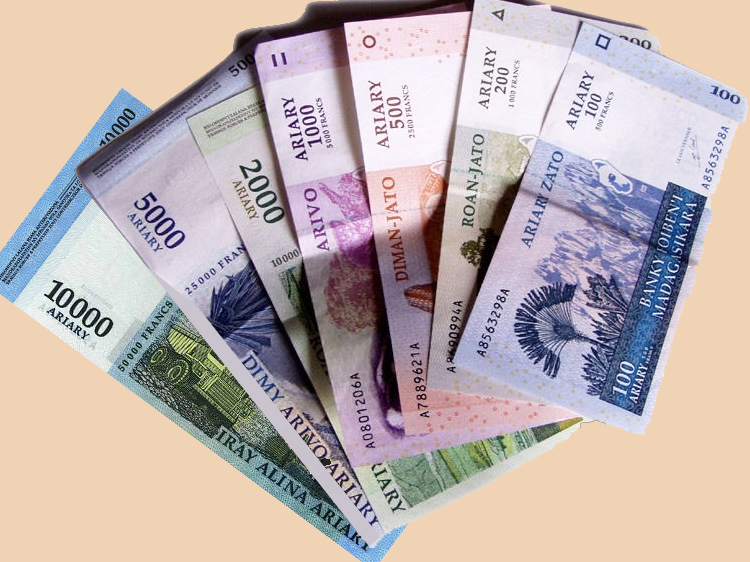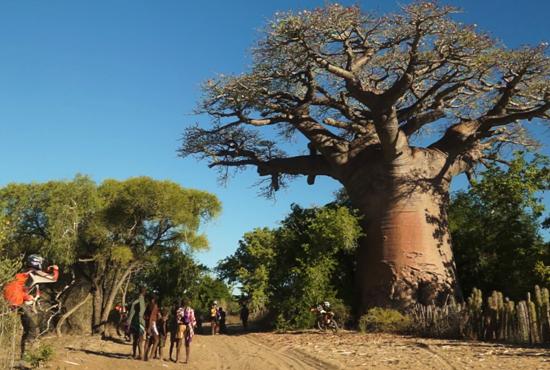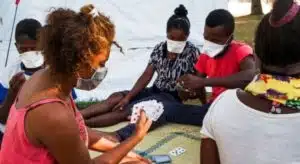The official currency of Madagascar is the Malagasy Ariary (MGA) since January 1, 2005. It was reintroduced under the first mandate of Marc Ravalomanana to replace the Malagasy Franc. The Ariary was first introduced in 1961, with 1 Ariary being worth 5 Malagasy Francs. The banknotes still show in small print how many Francs they were worth to avoid misunderstandings. There are banknotes of 10,000 Ariary (MGA), which are the largest banknotes available.
The current value of this banknote is approximately €3. In banknotes, there are also 5000 Ariary (MGA), 2000 Ariary (MGA), 1000 Ariary (MGA), 500 Ariary (MGA), 200 Ariary (MGA), and 100 Ariary (MGA). There are even aluminum coins in circulation, although they are of such low value that if they were made of a more expensive metal, the weight of the coins in the metal’s value would certainly be worth more than the currency itself. The inflation rate is very high, so I only provide the following exchange rate as an example, the actual exchange rate can be found on the internet. Formerly known as Franc (former Franken) = €3
5000 Ariary = 25000 Franc = €1.50
2000 Ariary = 10000 Franc = €0.60
1000 Ariary = 5000 Franc = €0.30
500 Ariary = 2500 Franc = €0.15
100 Ariary = 500 Franc = 0.03€
Important: Although the Madagascar Franc officially ceased to exist in 2005, prices are still often offered in the old currency, especially in rural areas, markets, some hotels, or in conversations with locals.
For inexperienced travelers, it is important to be aware of the two currencies, the valid one being Ariary or MGA and the former Franc. For almost 10 years, the (Franc Malgache) has been difficult to understand and convert. It is important to always make sure whether the prices quoted are in Ariary or in Franc to avoid paying 5 times the price if something, for example, is offered in Ariary and mistakenly paid for in Ariary. So it’s not a simple matter if you’re used to strong currencies like the Euro. There are several options upon arrival to obtain the local currency.

At the airport, there are several banks that exchange at the official rate, which can vary in different banks.
There are also 4 exchange offices, one on the left side of the parking lot, one in the domestic flights hall which usually offers the best rate, and two others in the international area where the two banks are also represented.
You may also be approached immediately to exchange money on the street or at the airport, but exchanging money on the illegal market is illegal and not advisable.
Not knowing someone well.
You probably get the best exchange rate for all major currencies when exchanging large bills, €50 to €500 bills are more in demand than €20, €10 or even €5 bills, this fact is particularly relevant in exchange offices and with illegal exchange rates.
En BNI / Crédit Agricole, necesitará el recibo original de compra con los números de serie de los cheques que desea intercambiar. La verificación puede llevar horas o incluso ser imposible en caso de problemas de internet.
Sin embargo, los bancos BNI / Crédit Agricole son los más recomendados para el intercambio de cheques de viaje. Los cajeros automáticos están disponibles en todas las principales ciudades, pero el monto suele estar limitado a un máximo de 150€, y solo se aceptan tarjetas Visa. MasterCard solo se acepta en sucursales de BNI, y no en otros lugares. Otras tarjetas no serán aceptadas en absoluto. Puede repetir la transacción tantas veces como desee, pero se le cobrarán tarifas por parte del banco corresponsal cada vez. Algunos bancos en Tana le ofrecen la opción de intercambiar cantidades mayores. Solicitar un cambio puede ser un proceso largo y que consume mucho tiempo que probablemente quiera evitar.








